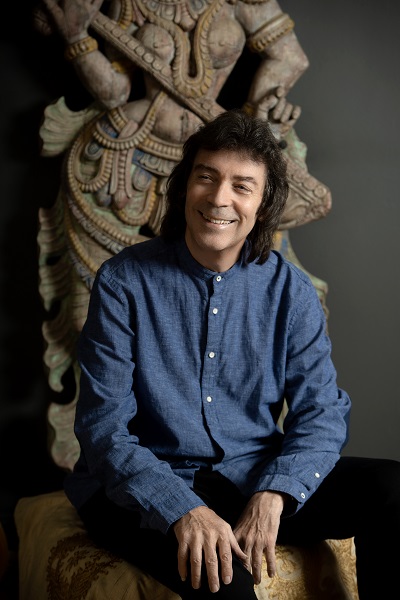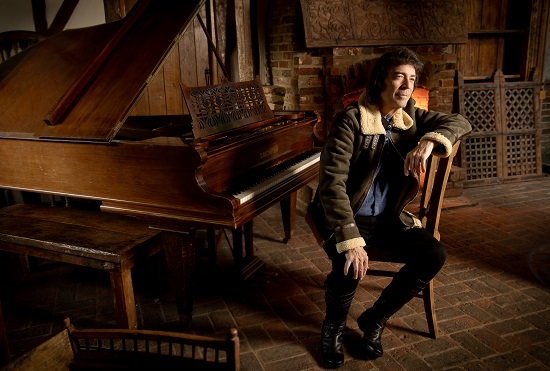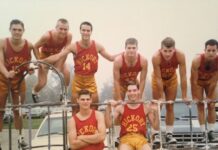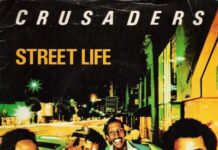Photos by Tina Korhonen
Steve Hackett’s fingers should be in the Smithsonian — given all they’ve created since the opening lines of “The Musical Box” came wafting in to introduce Genesis’ Nursery Cryme back in ‘71.
With musical ax in hand, the legendary guitarist and solo innovator has just released his 26th solo album At The Edge Of Light, a worldly effort boasting grandiose ideas and sounds inspired by all the typically reserved musician absorbs daily.
“Things come out of associations that are an extension of friendship, fellowship and conversation,” Hackett told me recently. “I’m influenced by everything I see, everything I read and I do read a lot of books. I’m an avid reader. Someone was saying to me … ‘A house without books is like a house without windows. I thought it was a great quote.’”
For all you bibliophiles out there who take Hackett’s advice to heart — he hopes you’ll add Colson Whitehead’s Pulitzer Prize-winning “The Underground Railroad” to your bookshelves and iPads.
“That was a fascinating book that I hope becomes a movie at some point,” he said. “I think it’s a natural.”
At the very least, it’s left its imprint on Hackett’s latest album on a gospel, slide blues, and hard rock-infused track (“Underground Railroad”). Quick side note, At The Edge Of Light makes for a great companion piece to Hackett’s previous studio effort — 2017’s The Night Siren — an album that finds itself rooted in world music, replete with ethnic instruments and a global sensibility of what’s affecting its inhabitants.
“I think that in many ways it’s twinned with that,” Hackett says. “Perhaps it’s, if anything, slightly lighter but then it has its heavy aspects too from the word go.
Hackett will hit the road in Europe and the UK this year, before ultimately heading to the U.S. On this trek, attendees can look forward to not only hearing Hackett unleash a majority of his seminal Spectral Mornings solo album (celebrating its 40th birthday), but the entirety of the 1973 Genesis classic Selling England By The Pound, their second-to-last album with frontman Peter Gabriel. While the album doesn’t boast a 23-minute behemoth like “Supper’s Ready,” it does have its fair share of band classics – “Dancing with the Moonlit Knight,” “I Know What I Like (In Your Wardrobe),” and the wholly underrated “The Battle Of Epping Forest” (“Here come the cavalry!”) — included.
“I think it’s the strongest Genesis album that we did as a five-man team,” Hackett told me. “It was an album that I very much enjoyed doing. I absolutely love it and adore it.”
SEBTP also marks a key turning point in the band’s history and fortunes — their influence over America.
“In ’72 when we were doing Selling England By The Pound, we were just starting to tour America for the first time. We couldn’t get any gig between New York and LA,” Hackett said. “John Lennon had given an interview to WNEW and said that we were one of the bands that he was listening to at that time in ’73. That was a huge plus for us, but we couldn’t use that information at the time. These days you tweet it and everyone would know about it and boom, you know, but it was several years before we were running properly in the states. Although it might seem in retrospect that 1972 was the world falling at our feet, it was far from the case.”
***
Hackett is the kind of artist that shines both within a group and as a solo superstar. Upon receiving word
I would be sailing away on 2017’s Cruise to the Edge, I did all I could to learn his musical language, ingesting one solo album after another, and marveling at the virtuosity of every track.
This column marks the second time Hackett and I have spoken with one another. The first took place on said cruise, where for 45 minutes, he waxed poetic about everything from The Night Siren, to Genesis’ classic Wind & Wuthering album, to the influence of folk icon Richie Havens on his music.
This time around, dear readers, I wanted to achieve a different experience — learning how several of Hackett’s noted guitar-driven compositions — directly in his own words – came to be. While it was admittedly difficult to whittle my window of recommended listener tracks to just 10 (as you’ll see below), these embody a strong start for any Hackett novice ready to start listening.
And yes, I am fully aware of how awesome “The Musical Box,” “Los Endos,” “One for the Vine,” “Shadow Of The Hierophant,” “Wolflight,” and “The Steppes” are, so no need to point out the fact they are missing here…
- “Firth Of Fifth” (1973) [From Selling England By The Pound]
“Tony (Banks) came in with a song that had a great melody. Peter Gabriel said to me, ‘I do believe Tony has finally written a blues.’ That’s how he saw it.
“I thought it had more of a gospel kind of feel. Perhaps it was slightly gospel-blues, but there was something definitely European about it. Then there was something of the South in it as well, almost a revival aspect with that organ.
“I doubled the bass with guitar to make the low-end sound brassy which mixed, I think, very well with the organ. I had just acquired an Echoplex, which meant I could do my own echoes. When we rehearsed that as a piano melody I suggested doing it on guitar and using bending notes and sustain.
“It ended up being Genesis’ longest guitar solo. It goes on for three minutes or so — as long as some of the tunes that the band’s done. I love doing that. It’s become absolutely iconic and much loved and I try and play it in all the concerts that I do now.
“It’s Genesis’ most well-known solo. A great tune and I still love it — the grand sweep of it.”
2. “it” (1974) [From The Lamb Lies Down On Broadway]
“Mike Rutherford came in with a melody that he was playing on an open-tuned — I don’t know if it was a Rickenbacker at the time or a Shergold he was using. Mike was very fond of taking 12-string guitars and doing strange tunings with them. He was able to play the main riff and, of course, the rest of us doubled the riff. We were all playing the riff. You get the bending notes from me and you get synth doing it as well.
“Pete came up with the lyrics that he did for all of The Lamb and we all basically came up with phrases around the chord sequence that Mike had. The sort of bare bones of it came from Mike; the rest of us filled in the spaces.
“It is very, very upbeat and of course consciously referential … The Lamb needed something like that at the end as sort of a release. Live, we used to twin it with ‘Watcher of the Skies.’ We used to let it drop down so the keyboard kept going and the chords come in, et cetera. It’s on Three Sides Live — you get that.”
- “Blood On The Rooftops” (1976) [From Wind & Wuthering]
“At the time when I was working on Wind & Wuthering, I noticed in the past that if Genesis did what was called a ‘guitar-based tune,’ it normally meant we had lots of 12-strings all chiming away at once, none more so than on Foxtrot and ‘Supper’s Ready’ or ‘[The] Cinema Show.’ But this time I thought, well what would it be like if you had nylon guitar or sometimes two? So, I was trying to head towards that to give it the more sort of harp-like sound and give it a little more either Spanish or Latin or South American influence.
“‘Blood On The Rooftops’ was influenced by the idea of channel surfing before the idea really caught on. There weren’t that many channels but even if you switched between the available two or three that we had in England at that time you still got this kind of feeling for what was going on; a sort of distillation of everything the media had to offer whether it was serious or downright flippant.
“At one point Phil (Collins) suggested the title of the song … He said, ‘Oh I imagine prisoners on a rooftop — a rooftop protest with their grievances being written in blood on sheets.’ The rest of the lyric reflected that — the idea of all the levels of action happening on the TV at one stage removed [and] the idea of the interplay or the conversation between father and son where you got the son interested in the news and the father — the implication is that having lived through the second World War. He doesn’t want to see any more violence so he just turns off. He’s apolitical, he’s seen enough of that in his lifetime. I guess he’s in denial, as it were.
“It’s an interesting tune and the loud bit of that, Phil Kicked in, he had the chord sequence from the melody line. The verse is mine, the introduction and the lyrics and the title are from Phil. I think it’s one of the tunes that to this day Tony Banks says that he thinks it’s one of the best. I have played it quite a bit in recent years … It’s one of the favorites.”
- “Please Don’t Touch” (1978) [From Please Don’t Touch]
“Originally there was a chord sequence that I used with Genesis with the track ‘Unquiet Slumbers For The Sleepers,’ which basically was an acoustic melody doubled with synths. It sounded a little bit like South American music but we did rehearse a version that was linked to a track that was eventually called ‘Wot Gorilla.’ I thought it was very strong.
“We changed one note in the harmony which gave it a more kind of oriental feel — very much like Japanese melodies. It was frenetic but there was also the influence of a section in 5/4; really I was thinking of Dave Brubeck’s “Take 5” with that. So, you had the more kind of out there stuff — the frenetic aspect — but twinned with the more melodic stuff.
“It was a track that was full of surprises. We had pipe organ on it. We had synth, guitars. We had Hammond Organ on it; we had two types of organ playing at once and I really went all out to try and make that as extraordinary as possible. Originally, we were going to have orchestra on it … In those days to get polyphony with a synth you had to have something about the size of a telephone directory; something taking up the whole wall of the studio with plugs and everything. But it came out really well.
“Absolutely thrilled with it. Unfortunately, we didn’t use it with Genesis but I think that the team that recorded it with Chester Thompson on drums and Tom Fowler on bass and many others did just such a great job on it.”
- “Every Day” (1979) [From Spectral Mornings]
“In a way, I wrote it on guitar but I was thinking very much in terms of keyboard. Nick Magnus, who I’m still very close to, had a way of making his Vox keyboard sound like a pipe organ. Again, pipe organ comes in because it’s always been important to me. So, we used that and he had a Hohner clavichord, the kind of thing Stevie Wonder used on ‘Superstition.’ We twinned it with guitar. We used piano again in a very organish mode.
“The band just sounded great from the word go on that. I thought wouldn’t it be fun if the vocals were all done in harmony.
“Lyrically it was about my first girlfriend who when we broke up she got heavily into drugs and just took everything known to man and suffered accordingly in later life. So really, it’s a drug song and it was about the perils of that. At the end of that, of course, it gets high as a kite … It is stated quietly first of all in true progressive fashion and then it’s blown up big. It was because there was nothing I could do to prevent her from embracing her fate in that.
“I cried a lot of tears over that, believe me, for all sorts of reasons.”
- “Clocks – The Angel of Mons” (1979) [From Spectral Mornings]
“First of all, it was a live number and then we took it back to the studio. When we were recording in Holland we were in a big 40-foot long studio … and we just had every mike in the place on this 40-second long drum solo. We used to call it ‘Elephants.’ John Shearer used to play double bass drums and do it all with toms and it just sounded like a herd of elephants running over you. It was kind of octopus handed or footed. A lot going on but it’s all one take and it sounds marvelous even to this very day.
A journalist wrote a story from the first World War who claimed that a legion of angels appeared in the sky that seemed to be on the side of the Allies …The whole thing was a fiction but somehow I ended up giving the track two titles because I couldn’t make up my mind between which one was which.
I was reading a lot of stuff at the time — a lot of spiritualist material, particularly the memoirs of Lord [Hugh] Dowding, who had been the Commander in Chief of the Battle of Britain. When I was working on “Tigermoth,” which was on the same album — it was the idea of people who had passed on that were suddenly discarnated and not realizing who they were or where they were.
So much of Spectral Mornings was dealing with not just death but survival of the spirit after death. The title track was all about that, so even the instrumentals tended to have a theme running throughout them.
-
- “Camino Royale” (1983) [From Highly Strung]
“The extraordinary melody at the beginning with the kind of Latin rhythm behind it, that was from Nick Magnus. I think it was a great melody. To this day even though I’ve done a lot of re-records of the track I still feel one day I must try to do it with full orchestra. The timing is actually very difficult to follow. But it has to be done one day.
“Most of it came from a dream. Camino Royale — the street in New Orleans; New Orleans had been an influence for quite some time because it’s a favorite of writers and filmmakers and musicians, all of that. Anyone who’s ever visited — you can’t help but fall in love with the place.
“I remember walking through the streets at three in the morning. Couldn’t sleep after a gig; I was absolutely wired. Everything was boarded up and it was still extraordinary. I dreamt the same event and in the dream things came to life and extraordinary things happened. Much of what’s in the song is a reflection of that. Even though I had left Genesis several years earlier, at one point I go through an entranceway and I’m back working with Genesis circa 1972, 1973 rehearsing in London with them when we first got our own light show. I used to go out with a long lead during rehearsals to see what it looked and sounded like and I could tell that there was something extraordinary going on. I experienced that again in the dream. This kind of dream within a dream thing.
“The kind of music that the band was playing sounded very much like chords. I couldn’t remember it exactly but it’s something that sounds anthemic but is also slightly syncopated. It’s very much a Genesis trait. I think where Tony Banks and Phil Collins saw eye to eye — their sort of intersection of different scores of that. So that’s some of what promoted that song.
“The chorus [‘Only the fool learns to get through’] actually came from reading Henry Miller, one of his books. It might have been [The Rosy Crucifixion] trilogy – Sexus, Plexus, Nexus — and it’s from one of those. It was a direct quote from him. The rest of the lyric I believe is mine.”
- “In the Heart of the City” (1993) [From Guitar Noir]
“You were asking me about the guitar synth sound. It was a Roland 300 Blue Boss. I think that I was trying to create a kind of urban cityscape in song. I had ideas as if all the activity in that was like little cells going on within the body. It was as if the city was the body and as individuals we were cells within it.
“The lyrics were all kind of dipping in and out and I wanted to create that feeling of — I’m searching for the right word here – detachment would be part of it but being in the midst of something but not feeling like you’re part of it. It was … that feeling of something that’s quite neurotic in a way. It’s all going on around you. It’s your home and yet you might not know the person next to you, you might not know your neighbor. That could be London; it could be New York, it could be any number of places in the great metropolis. I think it’s the idea of being dehumanized, and ambition and all those things that big cities symbolize.
“I think I had an idea of doing a siren in the middle of the night. I used a slide, I used the Roland. We DI-ed it; we used a lot of echo and reverb on it and I used an EBow to make the note longer to drive the string in a way. In those days guitar didn’t sustain that much, certainly a guitar synth, reliably. Also, there’s something of the sound of a trumpet about it. I first started doing guitar synths impersonating brass back with Please Don’t Touch on the track ‘Icarus Ascending’ — the idea of a guitar sounding a little bit like a sax or, as I say, a trumpet. There’s something of Miles Davis with the trumpet, there’s something with the Temptations’ use of trumpet, early things of the early 70s or late 60s where people were starting to take instruments and changing their perspective considerably. Reverb is still a great sound but the 300 did that particularly well so I did something that was almost like a fanfare on it. There’s also a kind of melancholic aspect to it I think.”
- “Tubehead” (2010) [From Out of the Tunnel’s Mouth]
“When I was doing that album, I had a studio but the ownership was being contested in a court case at the time, so I was recording at home. Suddenly we’re doing this in the living room – Roger King and I and we were having to move very fast. I wanted to be able to do things which were under the eye of the radar at the time.
“It was an early example of DI-ed guitar, bypassing the amp process and finding out whether rock guitar still sounded credible like that. And it did. It really sizzled, so it was a great noise and a great sound. It’s an instrumental and there’s something about it. It’s kind of jazz-rock in a way. There’s an aspect of fusion about it.
“I did do it live quite a bit with real bass and drums which sounded terrific. Live I always found I could never control it quite the way that it sounded with the studio version because the feedback on that is coming from the guitar itself — the Fernandes guitars that I was using then and often still use now. It had the onboard facility to feedback so it will feedback on the note that you’re playing around any tune or volume … I haven’t looked back. When I record these things I sometimes use amps but more often than not I opt for the virtual amps.”
10. “Those Golden Wings” (2019) [From At the Edge of Light]
“I think there were several influences on it. The front of it — not for the first time, [is] the influence of an imaginary Tchaikovsky ballet, the idea of setting the scene, something very romantic, stirring melodies and then getting into the song mainly just backed with 12-string. Then we have choruses coming in which I introduced very slowly. I introduced voices, a kind of Hollywood choir, a children’s choir. I did the children’s voices myself with nefarious electronic means.
“The idea of it is innocence and it’s basically a love song to my wife and dedicated to my wife. It’s about her experiences and my observation of her … She’s written books and made films. All of that is really dedicated to her. I wanted to do something that I felt was worthy of her. It’s a multi-faceted love song and it’s quite long.
“We start to get into orchestral stuff and chorale stuff and different types of choir. Stuff sung in Latin and rock stuff and then right at the end we’ve got one of the sequences in the tune done basically taking it to the mountain and repeating it with a big long solo with my old vintage Les Paul on it and letting rip, playing melodic slow lines but then fast ones, [and] salvos as well. I suppose it’s a typically progressive track on the album but it’s full of surprises because you don’t know what’s coming next. You don’t know if it’s going to be the whole band or it’s going to be the orchestra. It’s the idea of something for everyone — back to the idea of family entertainment.”

###
Share your feedback and suggestions for future columns with Ira at vinylconfessions84@gmail.com.




















